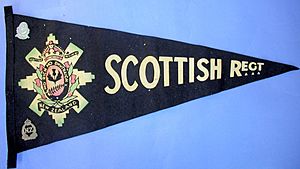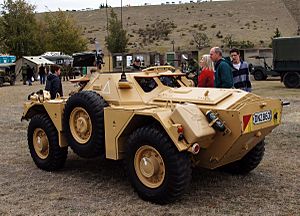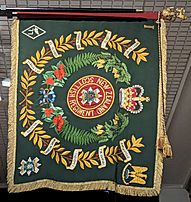New Zealand Scottish Regiment facts for kids
Quick facts for kids New Zealand Scottish Regiment |
|
|---|---|
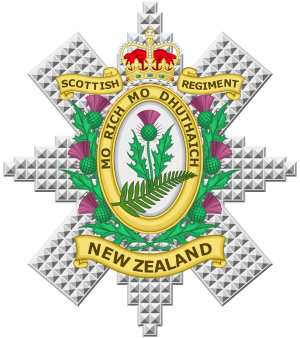 |
|
| Active | 1939–2013 |
| Country | |
| Branch | |
| Type | Infantry (1939–1943) Armoured reconnaissance (1948–2013) |
| Motto(s) | Mo rich mo dhuthaich (Scottish Gaelic: My king my country) |
| March | Highland Laddie |
| Commanders | |
| Colonel-in-Chief | Queen Elizabeth The Queen Mother |
| Insignia | |
| Tartan | Black Watch |
The New Zealand Scottish Regiment was a special part of the New Zealand Army. It started in 1939 as a group of foot soldiers, called an infantry regiment. They even formed two groups, called battalions, during World War II.
Even though one of their battalions went overseas, it never fought in a battle. After the war, in 1948, the regiment changed its role. It became a group that scouted ahead, using armoured vehicles. This was part of the Royal New Zealand Armoured Corps. Over the years, they used different armoured vehicles like Daimler Dingo Scout Cars and M113a1 armoured personnel carriers. The regiment was eventually closed down in 2013.
Contents
History of the Regiment
How the Regiment Started
In the late 1800s, some Scottish volunteer groups were set up in New Zealand. But their Scottish identity faded when they joined other army groups in 1911. During World War I, someone suggested forming a New Zealand Scottish regiment, but the idea was turned down.
A new idea came up in 1937 from the Dunedin Scottish Society. Many other Scottish groups in New Zealand supported it. Finally, the idea was accepted, and the New Zealand Scottish Regiment officially began on January 19, 1939.
The new regiment started with 135 soldiers in each of four main cities: Auckland, Wellington, Christchurch, and Dunedin. New soldiers usually had to be born in Scotland or have Scottish family history. However, this rule wasn't always strict. The regiment even had soldiers with Chinese and Maori Heritage.
Many people wanted to join, and by July 1939, the regiment was full. There was even a long waiting list! They thought about adding a fifth group, but it never happened. The regiment got special Highland Uniforms from Scotland. Queen Elizabeth The Queen Mother, who was in charge of the Black Watch regiment in Scotland, also became the leader of the New Zealand Scottish Regiment.
World War II Service
When World War II started in September 1939, the New Zealand Scottish Regiment wanted to go overseas to fight. But at first, they were told no. Instead, their soldiers were sent to other New Zealand army groups.
In October 1940, the Christchurch and Dunedin groups joined together. They formed a new battalion (a large army unit) with engineers and signallers. In January 1941, the two Scottish groups separated and grew into a full battalion. This was called the 2nd Battalion, New Zealand Scottish Regiment. (Even though there wasn't a 1st Battalion yet!)
Two more groups were formed, one in Invercargill and one in Oamaru. The soldiers of the 2nd Battalion trained together for three months. Then they went back to their home cities. In January 1941, another Wellington group was formed. The groups from the North Island then came together to form the 1st Battalion in December 1941. This 1st Battalion was based in Featherston. The 2nd Battalion came back together in March 1942 and was based in Ashburton.
In September 1942, it was announced that the 1st Battalion would go overseas. They would join the 3rd Division in the Pacific. The Battalion left New Zealand in late December and arrived in New Caledonia on January 1, 1943.
However, there weren't enough soldiers, so the 1st Battalion was closed down on July 1, 1943. The 1st Battalion never actually fought in a battle. Its soldiers were sent to other army groups or the Royal New Zealand Air Force. At this time, the 2nd Battalion was also closed down.
After the War

Even though the regiment was closed, it still existed on paper. It was started again in 1948, and many old members rejoined. The regiment was now part of the Royal New Zealand Armoured Corps. It was renamed the 1st Divisional Regiment (New Zealand Scottish).
One group (squadron) was in each of Auckland, Wellington, Christchurch, and Dunedin. The main headquarters was also in Wellington. At first, their job wasn't clear. But in 1950, it was decided they would be a reconnaissance unit. This meant they would scout ahead to gather information.
The regiment got Daimler Dingo Scout Cars and Daimler Armoured Cars. Its name changed again to 1st Armoured Car Regiment (New Zealand Scottish).
The Auckland Squadron was closed in 1961. The Daimler vehicles were replaced with Ferret armoured cars in 1962. More changes happened, and the Wellington Squadron and the main headquarters were closed in 1963. The remaining Christchurch and Dunedin squadrons were then renamed 1st and 2nd Reconnaissance Squadrons (New Zealand Scottish).
In 1970, the two squadrons were renamed again as 1st and 2nd Squadrons (New Zealand Scottish). They received M113a1 armoured personnel carriers between 1970 and 1973. These squadrons had both full-time soldiers and part-time soldiers (territorial force).
The 1st Squadron was part of a combat group in the North Island. But only a small group of full-time soldiers was based in Waiouru. The rest of the squadron were part-time soldiers in Christchurch. The 2nd Squadron was part of a reserve group in the South Island. It also had a small group of full-time soldiers. Each squadron was meant to carry an infantry company in their armoured vehicles. In 1979, the full-time soldiers of 1st Squadron moved to Burnham. A second group of full-time soldiers was added to 2nd Squadron and went to Waiouru.
In late 1981, the 2nd Squadron changed its role. It became an anti-armour squadron, using 106mm recoilless rifles on Land Rovers. The 1st Squadron was closed in 1990. The 2nd Squadron then became simply New Zealand Scottish, and its job was to provide security for rear areas.
In July 1993, the Royal New Zealand Armoured Corps was reorganized. The Queen Alexandra's Mounted Rifles became a full regiment. The New Zealand Scottish became one of its reconnaissance squadrons, using wheeled vehicles. Later, the full-time soldiers moved to another squadron. The remaining part-time soldiers became part of the 4th Otago and Southland Battalion Group. At first, the New Zealand Scottish existed as a separate company within this battalion. But this was later reduced to a smaller group (a platoon) and eventually closed. The remaining soldiers were spread throughout the battalion.
The 4th Otago and Southland Battalion Group joined with another battalion in 2012. They became the 2nd/4th Battalion, Royal New Zealand Infantry Regiment. The New Zealand Scottish Regiment was officially closed in 2013. However, its name and traditions were passed on to the New Zealand Scottish Squadron of Queen Alexandra's Mounted Rifles.
Regimental Colours and Battle Honours
In 1957, people started talking about giving special flags, called colours, to the New Zealand Scottish Regiment. Since they were an armoured car unit, it wasn't clear if they should get a "guidon" (used by mounted units) or a "stand of colours" (used by infantry). It was decided that colours were best because they honored the regiment's start as an infantry group.
The Governor-General, Sir Bernard Fergusson, gave the regiment a stand of colours in 1963.
The Regiment also received "battle honours." These are special awards for bravery in battles. These honours came from another regiment, the Divisional Cavalry Regiment (New Zealand). The following battle honours were allowed to be shown on the colours:
- Mount Olympus
- Crete
- Tobruk, 1941
- El Alamein
- Tebaga Gap
- Enfidaville
- The Sangro
- Cassino I
- Advance to Florence
- Bologna
The colours were "laid up" at the Toitū Otago Settlers Museum in 2016. This means they were placed there for safekeeping and display, as a way to honor the regiment. About 100 soldiers took part in the ceremony.
Memorials
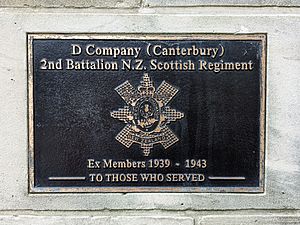
A special plaque on the Bridge of Remembrance in Christchurch remembers D Company, 2nd Battalion New Zealand Scottish Regiment.
Alliances
 United Kingdom – Black Watch (1939–2013)
United Kingdom – Black Watch (1939–2013) United Kingdom – Royal Scots Greys (2nd Dragoons) (1950–1971)
United Kingdom – Royal Scots Greys (2nd Dragoons) (1950–1971) United Kingdom – Royal Scots Dragoon Guards (1971–2013)
United Kingdom – Royal Scots Dragoon Guards (1971–2013)
Freedoms
The 2nd Squadron (New Zealand Scottish) was given the Freedom of the City of Dunedin in 1977. This is a special honor given by a city. The last time they used this honor was in 2016, when the colours were laid up and the special document (charter) was returned to the Dunedin City Council.


